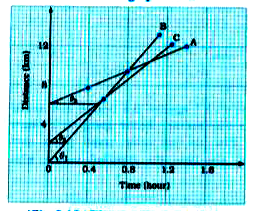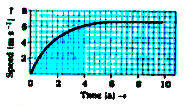Complete Solutions to ANSWER THE FOLLOWING of chapter MOTION of Class 9 book with complete answers and questions
| Class 9 | PHYSICS |
| Chapter | MOTION |
| KUMAR PRAKASHAN | ANSWER THE FOLLOWING |
| Number Of Questions | 24 |
| Academic Year | 2023-24 |
A man travels a distance of 1.5 m towards East, then 2.0 m towards South and finally 4.5 m towards north.
(i) Calculate the total distance travelled.
(ii) Calculate the resultant displacement.
View SolutionJoseph jogs from one end A to the other end B of a straight 300 m road in 2 minute 30 second and then turns around and jogs 100 m back to point in another 1 minute. What are Joseph's average speeds and velocities in jogging (a) from A to B and (b) from A to C?
View SolutionAbdul, while driving to school, computes the average speed for his trip to be 20 km `h^(-1).` On his return trip along the same route, there is less traffic and the average speed is `30 km h^(-1).` What is the average speed for Abdul's trip?
View SolutionThe distance-time graph of three objects A, B and C is shown below. Study the graph and answer the following questions :

: Distance-time graph)
(a) Which of the three is travelling the fastest?
(b) Are all three ever at the same point on the road ?
(c) How far has travelled when B passes A?
(d) How far has B travelled by the time it passes C?
View SolutionA train travels at a speed of `60 km h^(-1)` for `0.5 h, 24 km h^(-1)` for the next 0.25 h and then `72 kmh^(-1)` for the next 0.75 h. Calculate the total distance covered by the train and its average speed.
View SolutionA ball is gently dropped from a height of 20 m. If its velocity increases uniformly at the rate of `10 ms^(-2),` with what velocity will it strike the ground ? After what time will it strike the ground?
View Solution(a) A body thrown in the vertically upward direction rises up to a height 'h' and comes back to the position of rest. Calculate the displacement of the body.
(b) A body starts to slide over a horizontal surface with an initial velocity of `0.5 m s^(-1).` Due to friction, its velocity decreases at the rate of 0.05 `ms^(-2).` How much time will it take for the body to stop ?
View SolutionAn athlete completes one round of a circular track of diameter 200 m in 40 s. What will be the distance covered and the displacement at the end of 2 minute 20 s?
View SolutionA driver of a car travelling at the speed of `52 km h^(-1)` applies the brakes and accelerates uniformly in the opposite direction. The car stops in 5 s. Another driver going at `34 kmh ^(-1)` in another car applies his brakes slowly and stops in 10 s. On the same graph paper, plot the speed versus time graphs for the two cars. Which of the two cars travelled farther after the brakes were applied ?
View SolutionThe speed-time graph of a car is shown in figure given below

Speed-time graph]
(a) Find how far does the car travel in the first 4 second. Shade the area on the graph that represents the distance travelled by the car during the period.
(b) Which part of the graph represents uniform motion of the car ?
View SolutionDerive graphically `s = ut + (1)/(2) at ^(2),`where symbols have their usual meaning.
View Solutionwrite three equations of motion.
View SolutionA man travels a distance of 1.5 m towards East, then 2.0 m towards South and finally 4.5 m towards north.
(i) Calculate the total distance travelled.
(ii) Calculate the resultant displacement.
View SolutionJoseph jogs from one end A to the other end B of a straight 300 m road in 2 minute 30 second and then turns around and jogs 100 m back to point in another 1 minute. What are Joseph's average speeds and velocities in jogging (a) from A to B and (b) from A to C?
View SolutionAbdul, while driving to school, computes the average speed for his trip to be 20 km `h^(-1).` On his return trip along the same route, there is less traffic and the average speed is `30 km h^(-1).` What is the average speed for Abdul's trip?
View SolutionThe distance-time graph of three objects A, B and C is shown below. Study the graph and answer the following questions :

: Distance-time graph)
(a) Which of the three is travelling the fastest?
(b) Are all three ever at the same point on the road ?
(c) How far has travelled when B passes A?
(d) How far has B travelled by the time it passes C?
View SolutionA train travels at a speed of `60 km h^(-1)` for `0.5 h, 24 km h^(-1)` for the next 0.25 h and then `72 kmh^(-1)` for the next 0.75 h. Calculate the total distance covered by the train and its average speed.
View SolutionA ball is gently dropped from a height of 20 m. If its velocity increases uniformly at the rate of `10 ms^(-2),` with what velocity will it strike the ground ? After what time will it strike the ground?
View Solution(a) A body thrown in the vertically upward direction rises up to a height 'h' and comes back to the position of rest. Calculate the displacement of the body.
(b) A body starts to slide over a horizontal surface with an initial velocity of `0.5 m s^(-1).` Due to friction, its velocity decreases at the rate of 0.05 `ms^(-2).` How much time will it take for the body to stop ?
View SolutionAn athlete completes one round of a ciruclar track of radius R in 40 seconds. What will be his diplacement at the end of 2 minute 20 second?
View SolutionA driver of a car travelling at the speed of `52 km h^(-1)` applies the brakes and accelerates uniformly in the opposite direction. The car stops in 5 s. Another driver going at `34 kmh ^(-1)` in another car applies his brakes slowly and stops in 10 s. On the same graph paper, plot the speed versus time graphs for the two cars. Which of the two cars travelled farther after the brakes were applied ?
View SolutionThe speed-time graph of a car is shown in figure given below

Speed-time graph]
(a) Find how far does the car travel in the first 4 second. Shade the area on the graph that represents the distance travelled by the car during the period.
(b) Which part of the graph represents uniform motion of the car ?
View SolutionDerive graphically `s = ut + (1)/(2) at ^(2),`where symbols have their usual meaning.
View SolutionDerive graphically `v ^(2) = u ^(2) + 2as,` where symbols have their usual meaning.
View Solution
ANSWER THE FOLLOWING questions and complete solutions for chapter MOTION of KUMAR PRAKASHAN KENDRA PHYSICS (GUJRATI ENGLISH) of Class 9